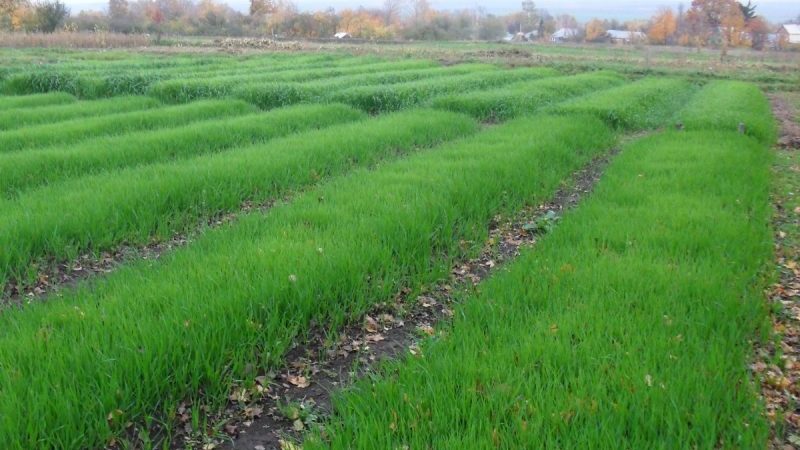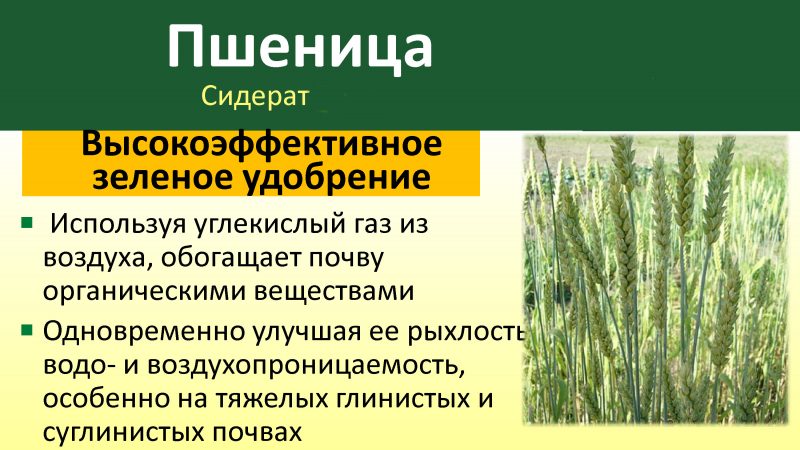Guide to using wheat as a green manure in fall and spring
The successful use of wheat as a green manure has long been confirmed by practice. It has all the qualities of a green fertilizer - a cheap and effective technology for restoring soil fertility after active use.
The content of the article
- What is siderat
- Why wheat is good as a green manure in autumn and spring
- Which is better: winter or spring wheat
- Sowing dates of wheat green manure in autumn
- Wheat sowing technology
- Terms and conditions of sideration
- What can wheat be combined with as green manure
- Harvesting green manure
- Experienced Farmer Tips
- Conclusion
What is siderat
Siderat is a plant that is grown on a temporarily empty plot of land in order to enrich the soil. These are mainly annual crops. Subsequently, the green mass is plowed into the soil before or after flowering. This method saturates the soil with macro- and microelements in an easily accessible form, improves its structure, and suppresses the growth of weeds. A humus layer is created on the surface, and the root system of the green fertilizer feeds worms and beneficial microbes that process nitrogen.
 Green manure crops, in addition to enriching the soil, have sanitary qualities: they fight bacteria, fungal spores, and suppress the reproduction of pests.
Green manure crops, in addition to enriching the soil, have sanitary qualities: they fight bacteria, fungal spores, and suppress the reproduction of pests.
Important! The technology of sowing intermediate plants satisfies one of the main principles of preserving fertility - agricultural land should not remain without vegetation.
Why wheat is good as a green manure in autumn and spring
The use of wheat as an autumn green manure is to increase the physical and biological composition of the soil and reduce erosion. Grain grows green mass in the shortest possible time. The foliage rich in organic matter creates a protective cover during cold weather, quickly decays in spring and increases the humus content in the upper soil layer.
A maximum of 1.5 months pass from seed germination to mowing. Grain is sown on the site where it is planned to plant vegetable plants and greenery.
In early spring, wheat can be sown in beds that will be occupied by thermophilic crops with a late planting date. Its seedlings will protect the soil from drying out and weathering, and will scare off some pests.
After 12-14 days, the stems are cut off, composted or mulched. From this point on, it should take about two weeks before planting seedlings, so that soil microorganisms have time to decompose the fibrous root system of the cereal. To speed up the process, special preparations are used based on beneficial bacteria and yeast.

Advantages and disadvantages
The use of wheat as a green manure:
- It does not require special care.
- The branched root system of the cereal suppresses the growth of weeds.
- Useful for all types of soil, especially in areas with a strong slope, in rainy and windy areas.
- Greens can be used as animal feed.
- Grain returns useful substances back to the ground, recycles sparingly soluble compounds.
- Reduces subsequent fertilization, improves the quality and quantity of future crops.
The disadvantage of wheat is that after it you cannot sow another crop from the cereal family, since they have the same nutrition and diseases. In addition, the culture attracts the wireworm.
Important. Plants need to be harvested before grains are formed, otherwise the use of wheat as a green manure will significantly decrease.
For which crops is suitable
After wheat, any vegetables and root vegetables. Gardeners note the positive effect of green manure on the harvest potatoes, garden strawberry. Cucumbers, squash and greens will quickly enter the growing season due to available nitrogen.
Which is better: winter or spring wheat
Wheat is grouped into spring and winter varieties. For each region of agriculture, the variety is chosen that will give more yield in these conditions.
Biological features of both species

Spring wheat differences:
- more vulnerable to diseases and pests;
- unsuitable for acidic soils;
- hard varieties require the introduction of nutrients, an abundance of moisture;
- can be sown before winter, sprout at + 2 ° C;
- it is impossible to cultivate podzolic soils with it.
Spring crops will be beneficial only on land already put into operation.
The yield is on average 25% higher. For areas with unpredictable weather conditions, winter wheat is ideal:
- withstands temperature extremes, drought-resistant;
- rises earlier in autumn, is not damaged by frost;
- in spring it quickly gains green mass.
However, with little snow, but frosty winters, the risk of freezing is high.
Sowing dates of wheat green manure in autumn
In mild and warm climates, green manures are sown from mid-autumn. In harsher conditions, work should be completed by mid-October, during the Indian summer.
Winter varieties are sown only in autumn, after the land is vacated, since they require vernalization at sub-zero temperatures. Minor shoots will appear before winter, and active growth will begin after the snow melts. If sown in the spring, the seedlings will be sparse and weak, the sideration effect will be minimal.
In the spring
Spring green manures are sown at an air temperature of + 5 ° C, land - from + 3 ° C. Work begins as early as possible, when there is still enough moisture in the soil for seed germination. If this moment is missed, then the yield will decrease by 25%.
Meeting the deadlines for spring wheat is necessary for the formation of a secondary root system, which increases the tillering of the plant.
Wheat sowing technology
The seeding depth depends on the condition of the soil - on sandy and sandy loam, 8-10 cm are permissible. On clay and loams, the embedding is shallow, 3-4 cm. Mineral and organic fertilizers are added if desired. If the greens will not be fed to pets, then you can spray the area with herbicides.
The seeds are pre-soaked in an antifungal agent or manganese solution. Then they are dried and heated in the sun.
Winter
Before sowing the cereal, all plant residues are removed from the beds. The earth is dug up to the depth of a shovel bayonet or harrowed with a rake. If the soil is dry, then moisten it 2-3 days before work.
The required amount of seed material is evenly scattered, embedded in the ground with a rake and covered with a small amount of compost. After a while, it is advisable to water.
Spring
After the snow melts, the blocks of earth are leveled with a rake. The best way to sow spring crops is in furrows, it increases the yield increase and reduces the occupied area.
In the fall, spring crops must have time to pick up greens 40-45 days before frost.
Terms and conditions of sideration

The main rule for choosing green manure is that the culture and subsequent plants belong to different families.so that there is no shortage of the same microelements and common pathogens.
Conditions for successful greening:
- the soil must be loose;
- the seeds are rolled for better contact with the ground;
- green tops need to be mowed in time so that the stems do not become too dense.
Attention! Make sure that the birds do not gnaw the seedlings.
What can wheat be combined with as green manure
Combining wheat with other green manures gives even more benefits to the land. The combination with legumes completely covers the need for nitrogen and potassium.
Barley, rye, oats are also used as siderates from cereals. Barley grows well in symbiosis with lupine.
Examples of mixtures:
- for future planting of potatoes: wheat - 30%, vetch - 20%, rapeseed, radish and mustard - 15% each;
- after onions: in equal parts wheat, lupine, oil radish, mustard, vetch, rapeseed;
- after nightshades: wheat, peas, lupine - 20%, radish and mustard - 15% each, rapeseed - 10%.
Harvesting green manure
Green manure is processed in two ways.
Direct burial:
- Wheat is pruned with a flat cutter at a depth of 5-6 cm, the greens are harvested and ground.
- The finished biomass is watered with any EM-preparation and buried for digging, about 8-12 cm deep.
Mulching:
- The greens are mowed, finely chopped with a bayonet shovel, watered with water.
- After 2-3 days, sprinkle with rotted compost or watered with a solution of special bacteria.
- The mass is distributed over the surface of the beds 10-15 days before planting vegetables and other crops, so that the humification process is completed.
- For seedlings and sowing of seeds, recesses of the desired size are made directly in the mulch.
You can leave the cut tops lying in the snow without treatment. It creates a protective layer against overheating and waterlogging, stimulates the growth of the worm population. The root system will loosen the soil as much as possible, increase the number of humic microorganisms.
Important! If you plant seedlings next to an adult wheat, then its powerful root system will suppress the growth of a young plant, up to death.
Experienced Farmer Tips
Experienced farmers believe that the correct use of green manure crops is equivalent to the introduction of manure. The benefits for the garden will be equivalent, while the green manure is much cheaper and easier in terms of labor costs.
A mixture of wheat and mustard will provide excellent soil disinfection. Due to the phytosanitary properties of mustard, the cereal will not be infected by the pathogen, pests also leave such places.
A large amount of wet mass must not be embedded in the ground. It will not have time to decompose and will turn sour. The more greenery has grown, the deeper and wider the planting in the garden.
It is interesting:
How and when to mow oats like green manure.
Why rye is good, how green manure is in the fall and how to plant it correctly.
Conclusion
Growing wheat as a green manure eliminates many of the problems associated with soil restoration and rehabilitation. Supporters of organic farming have long and successfully used cereals in combination with other plants.